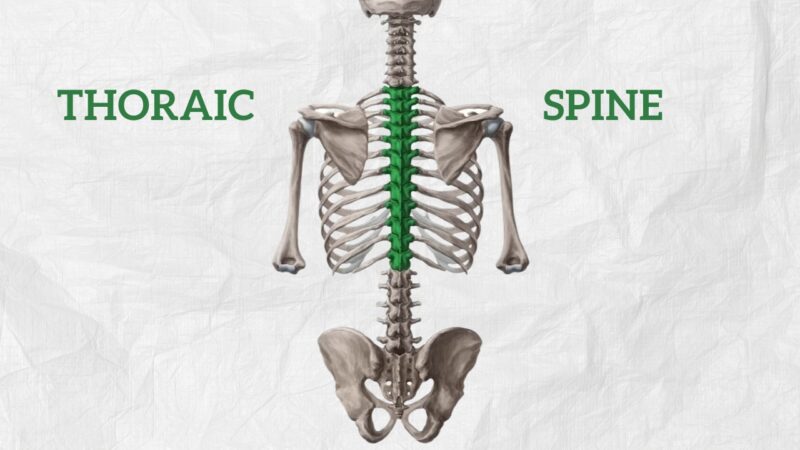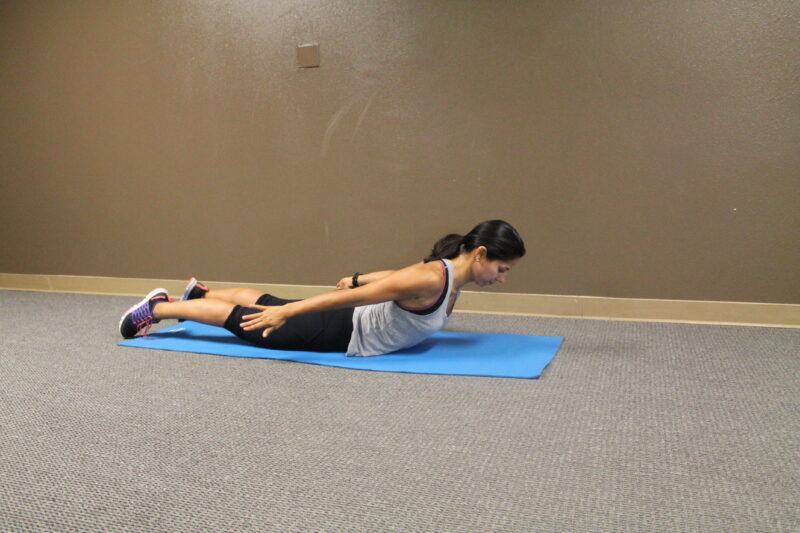For most of us, our daily practices involve sitting at a desk, looking down at our phones, or slouching on the couch while watching television. Eventually, we may catch ourselves falling into a poor posture or even worse, don’t even realize it. Unfortunately, this is how people live today in modern times, which is of course not natural. That’s why I will show you 6 Thoracic mobility exercises for great flexibility.
Your upper back, also called the thoracic spine, is the part from your mid back up to your neck. It’s super important, but lots of people don’t think about moving it. That’s because we usually just move the front of our bodies and not our backs. Not having good movement in this part of your body can cause problems.
It means you can’t lift your arms up over your head very well. And if that area is really tight, your body might find other ways to move that aren’t as good, like bending too much in your lower back. So getting your upper back loose and mobile is a big deal. It helps you move better and could help prevent injuries too. But most people don’t work on their upper rear like they do on their fronts.
Why is it so important?

There are a few BIG reasons why Thoracic mobility exercises are such important:
- It can help prevent shoulder pain! A lot of shoulder issues happen because the upper back is too tight. Stretching and moving it can stop shoulder problems from starting.
- It lets your shoulder blades sit right. Your shoulder blades need to move a certain way for your shoulders to work properly. A mobile upper back allows this.
- It keeps your rear from hunching forward too much. Hunching rounds your upper back, which can pinch nerves and restrict how high you can lift your arms. We don’t want that!
I suggest combining mobility work and soft tissue treatment from a local therapist. The key areas to focus on will be pec minor, pec major, lats, teres major, and anterior delts. If you have poor thoracic mobility, I recommend performing thoracic mobility daily. Below are 6 exercises that have proven effective in increasing thoracic extension and rotation.
6. Thoracic Extension w/ Roller & Bar
This is an awesome exercise to help improve your thoracic extension. To start, set up a bar and roller on the floor. Place the roller on your upper back and then reach your arms overhead to grab the bar. There are two ways to position your hands for this exercise. The first way is to place your hands close together, which will help stretch your lats and teres major muscles.
The second way is to place your hands wide apart, which will help stretch your pecs. When doing this exercise, it’s really important to remember to breathe. Take deep breaths in and out to help you relax into the stretch. Try to hold the stretch for 90 seconds and do multiple sets.
5. Cat-Camel Drill
This exercise is a great way to improve the flexibility of your upper back. Start on your hands and knees, with your hands directly under your shoulders and your knees directly under your hips. Slowly arch your back up towards the ceiling, letting your head and tailbone drop down.
This is the “cat” position. Then, slowly curve your back down towards the floor, lifting your head and tailbone up. This is the “camel” position. As you do this exercise, it’s important to breathe in as you arch your back up and breathe out as you curve your back down. I recommend starting with 10-12 repetitions for multiple sets.
4. Deep Squat + Thoracic Rotation
The deep squat with thoracic rotation is a more challenging exercise that helps prepare you for the overhead squat. There are two ways to do this exercise. The first way is to do it without any weight, and just focus on doing a certain number of repetitions. The second way is to hold a lightweight (2-3 kilograms) and hold the position for a short period of time.
The goal of this exercise is to stay in a deep squat position while reaching overhead with one arm. Make sure to keep your hips stable and focus on rotating your upper body. Start with 3 sets of 8 repetitions on each side.
3. Spiderman with Thoracic Rotation
The spiderman with thoracic rotation is a great exercise for improving hip mobility and upper back rotation. To start, get into a push-up position. The first step is to bring one leg up and outside your hand. You should feel a stretch in the hip flexors of your back leg and the inner thigh of your front leg.
The second step is to reach up towards the sky with the hand on the same side as your front leg, making sure to rotate your upper body through your thoracic spine. Hold the top position for 3-5 seconds, then switch to the other side. Start with 6-8 repetitions on each side for multiple sets.
2. Side-Lying Thoracic Windmill
The side-lying windmill is a great exercise to improve upper back flexibility and rotation. To start, lie down on your side with your hips and knees bent at a 90-degree angle. Place a foam roller under your top knee for support. Reach your top arm up and over your head, keeping your arm straight.
Try to touch the floor on the opposite side of your body with your hand. As you reach, focus on rotating your upper body through your thoracic spine. Begin with 6-8 repetitions on each side for multiple sets.
1. Preacher position with a stick
The preacher position is first on our list for Thoracic mobility exercises. It is an exercise that helps strengthen the muscles in your upper back and shoulders. You can do it using a special bench called a preacher bench, or you can use a stick or dowel instead. Here’s how to do the preacher position with a stick:
- Stand with your feet shoulder-width apart and hold a stick or dowel with both hands, using an overhand grip.
- Bend your knees a little bit and lean forward from your hips, keeping your back straight.
- Bring the stick up to your chest, keeping your elbows close to your sides.
- Squeeze your shoulder blades together, as if you were trying to hold a pencil between them.
- Hold the position for a few seconds, then relax and repeat for the desired number of repetitions.
The preacher position can be done for multiple sets of 8-12 repetitions, depending on your fitness level and goals. It can be used as a warm-up exercise or as part of a strength-training routine. Just make sure to use the proper form and to start with a weight that is appropriate for your fitness level. If you have any injuries or medical conditions, it’s always a good idea to talk to a healthcare professional before starting a new exercise program.
Summary
I believe it’s important to take care of your upper back, also known as the thoracic spine, because it helps us move better and can prevent injuries. Unfortunately, many of us, including myself, have poor posture and don’t move our upper backs enough, which can cause problems like shoulder pain and a hunched back.
To improve my upper back mobility, I can do exercises like the thoracic extension with a roller and bar, the cat-camel drill, the deep squat with thoracic rotation, the spiderman with thoracic rotation, the side-lying thoracic windmill, and the preacher position with a stick. It’s also a good idea for me to combine mobility work with soft tissue treatment from a therapist. If I have poor thoracic mobility, I will try to do these exercises daily to improve my upper back flexibility and movement.

